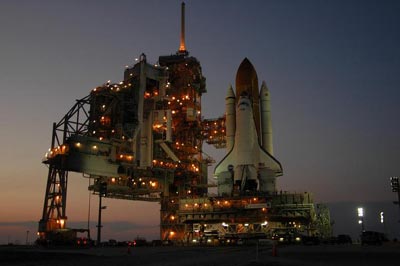Asking NASA tough questions about the ISS and shuttleby Eric R. Hedman
|
| What has triggered my questions about NASA is their lack of a plan for the ISS and their struggles to get the shuttle flying. |
Prior to the shuttle-Mir missions of the 1990s and assembly of the ISS the shuttle flew an ascent profile that subjected the vehicle to less aerodynamic forces than the current ascent profiles. I am assuming (but not sure) that the ascent profile was changed because the highly inclined orbits of both the Mir and ISS significantly reduced the lifting capacity of the Shuttle when trying to reach them.
I would like to know a few things about the changes to the shuttle. Launch vehicles have been by nature somewhat fragile. Did the combination of removing the paint on the external tank, changing the gas used to apply the foam, and changing the ascent profile make the shuttle too fragile to fly? Would putting paint back on at least portions of the external tank facing the orbiter toughen it enough to prevent foam shedding?
The repairs to the shuttle have the look and smell of Band-Aids. They are patches on a fragile system. Removing the PAL ramp and shaving foam off of certain areas of the tank are not ideal solutions. These changes don’t fix the root cause of the problems, but with the short time left for flying the shuttle, they may not have time or the money to fix the basic underlying problems. The biggest question I have for NASA is: have they learned the lessons they really needed to from the problems with the shuttle?
Toyota has a philosophy in the engineering and manufacturing of cars called “the five whys”. It is based on the idea that if you ask five questions you can find the ultimate cause of a problem. While it may not be possible in all situations, they want to eliminate the problem so they never have to address it again. They do not want Band-Aid fixes that have to be constantly addressed. A work around is not considered a solution.
| After all the money that has been spent on it, I expect to see a plan to use the ISS or I don’t want to see one more risky shuttle flight heading to it. |
Paul O’Neill, the former treasury secretary, is using the “five whys” philosophy to improve a chain of hospitals in Pennsylvania. As the former CEO of Alcoa, he brought a new approach to healthcare to address serious problems hospitals have been ignoring that range from infections caught in hospitals to patients dying from receiving the wrong prescriptions. Using this approach, the hospitals he is in charge of have greatly reduced the incidences of patient infections and drug mistakes and the mortality from them. Instead of taking the typical accounting approach of trying to reduce operating costs, he tackled serious problems that had Band-Aid fixes. The hospitals identified procedures that people thought were just normal operating methods but were really serious problems and changed them. The results have been better patient care and outcomes, dramatically reduced infection rates and prescription errors, along with a major reduction in costs associated with them. I recommend the PBS show about what he is doing very highly.
Attacking and eliminating the root cause of problems is a major change in philosophy for most organizations that results in a vastly improved bottom line results. If you look at the sales figures and the profit and loss statements in the auto industry, you can’t seriously argue with Toyota’s methods of rooting out problems. Cultural problems were identified within NASA as one of the reasons for the Columbia tragedy. A cultural change to permanently eliminate problems is what NASA truly needs.
The International Space Station has been horrifically expensive. NASA either has no serious plan for using this investment of tax dollars or has not publicized one. If you count all the money spent starting with the original design first publicly pushed under the Reagan administration and the cost of the shuttle program since then, the ISS probably has cost at least $100 billion dollars. Are we to abandon it once flights to the Moon start? Are we to finish it and do little or no research on it? Are we to maintain it just for our foreign partners? After all the money that has been spent on it, I expect to see a plan to use the ISS or I don’t want to see one more risky shuttle flight heading to it. I think NASA has some questions to answer.
